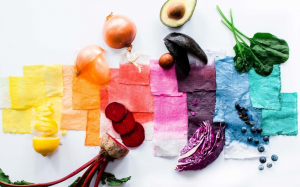NATURAL FOOD DYES
Gather at least one cup of leftover fruit and vegetable bits. Chop the fruits and veggies to allow more color to saturate the dye.Add the chopped food scraps to a saucepan and cover with twice as much water as the food quantity. For one cup of scraps, use two cups of water.Bring the water to a boil. Reduce heat and simmer for approximately one hour, or until the dye reaches the desired color.Turn off heat and let the water come to room temperature.Strain the cooled dye into a container.
HOW TO DYE FABRICS
Natural food dyes can create lovely one-of-a-kind shades for clothing, fabric and yarn, but natural fibers require an extra step of preparation to hold natural dye. Fabrics require the use of a fixative, also called a mordant, to adhere the colors to the clothing. Here’s how to create long-lasting colored fabrics:
For fruit dyes, simmer fabric in ¼ cup salt and 4 cups water for approximately one hour. For vegetable dyes, simmer fabric in 1 cup vinegar and 4 cups water for approximately one hour. After the hour, carefully rinse the fabric in cold water. Gently wring excess water from fabric. Immediately soak fabric in the natural dye until it reaches the desired color. Place the dyed fabric in a container overnight or up to 24 hours. The next day, rinse the fabric under cool water until the water runs clear. Hang to air dry. To further set the dye, run the fabric through a dryer by itself.
SAFETY WITH DYES
Even though a fixative, or mordant, is necessary for dyeing fabric, some fixatives are dangerous to use. Chemical mordants such as iron, copper and tin, which have fixative properties, are toxic and harsh chemicals. That’s why salt is recommended as a natural fixative.
Regardless of the fixatives and natural products you use, make sure to use separate pots, containers and utensils for your dye projects. Use these tools only for dyeing and not for cooking or eating. When you dye fabric, remember to wear rubber gloves or you might end up with stained hands.
Lastly, choose an environment in which to dye that offers good ventilation where you can store your equipment and extra dye away from the home environment, like that shed out back or your garage. Bathrooms and kitchens are not recommended.
Post time: Apr-02-2021











